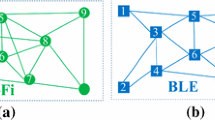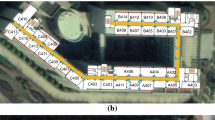Abstract
An important requirement for many novel location based services, is to determine the locations of people, equipment, animals, etc. The accuracy and response time of estimation are critical issues in location estimation system. Most of the location estimation system suffers with the problem of scalability and unavailability of all the access points at all the location for large site. In this paper, we have proposed a distributed semi-supervised location estimation method, which divide the location estimation system into subsystems. Our method partition the input signal space and output location space into clusters on the basis of visibility of access points at various locations of the site area. Each cluster of input signal space together with output location subspace is used to learn the association between Received Signal Strength fingerprint and their respective location in a subsystem. Previous methods for location estimation in indoor wireless networks require a large amount of labeled data for learning the radio map. However, labeled instances are often difficult, expensive, or time consuming to obtain, as they require great efforts, meanwhile unlabeled data may be relatively easy to collect. So, the use of semi-supervised learning is more feasible. On each subsystem at first, we use Locally Linear Embedding to reduce the dimensions of data, and then we use semi-supervised learning algorithm to learn the radio map. The algorithm performs nonlinear mapping between the received signal strengths from nearby access points and the user’s location. It is shown that the proposed Distributed Semi-Supervised Locally Linear Embedding scheme has the advantage of robustness, scalability, useful in large site application and is easy in training and implementation. We have compared our results with Distributed Subtract on Negative Add on Positive (DSNAP) and benchmark method RADAR. Experimental results show that our method provide better results in terms of accuracy and response time in comparison to centralized systems, in which a single system is used for large site as well as with DSNAP and benchmark method RADAR.
Similar content being viewed by others
References
Ahmad, U., Gavrilov, A., Lee, S., & Lee, Y. (2008). A modular classification model for received signal strength based location systems. Neuro Computing, 71(13–15).
Ahmad U., Gavrilov A., Lee Y., Lee S. (2008) Context-aware, self-scaling Fuzzy ArtMap for received signal strength based location systems. Soft Computing-A Fusion of Foundations, Methodologies and Applications 12(7): 699–713
Bahl, P., & Padmanabhan, V. (2000). RADAR: An in-building RF-based user location and tracking system. In Proceedings of 19th IEEE annual joint conference of computer and communications societies, INFOCOM 2000 (Vol. 2, pp. 775–784).
Bahl, P., Padmanabhan, V., & Balachandran, A. (2000). Enhancements to the RADAR user location and tracking system. Microsoft Research (MSR-TR-2000-12), 13.
Battiti, R., Nhat, T., & Villani, A. (2002). Location-aware computing: A neural network model for determining location in wireless LANs. Technical Report DIT-02-083, Ingegneria e Scienza dell’Informazione, University of Trento.
Chen, C. (2005). Hybrid location estimation and tracking system for mobile devices. In Proceedings of 61st IEEE vehicular technology conference, VTC 2005 (Vol. 4, pp. 2648–2652).
Ding, X., Li, H., Li, F., & Wu, J. (2008). A novel infrastructure WLAN locating method based on neural network. In Proceedings of 4th Asian conference on internet engineering (pp. 47–55).
Hightower J., Borriello G. (2001) Location systems for ubiquitous computing. Computer 34(8): 57–66
Jain, V., Tapaswi, S., & Shukla, A. (2010). Distributed growing radial basis function neural networks for location estimation in indoor wireless networks. In 6th International conference on wireless communications networking and mobile computing (WiCOM) (pp. 1–6). doi:10.1109/WICOM.2010.5601059.
Jain, V. K., Tapaswi, S., & Shukla, A. (2011). Sslle: Semi-supervised locally linear embedding based localization method for indoor wireless networks. In IJCCI (NCTA) (pp. 138–146).
Jain, V. K., Tapaswi, S., & Shukla, A. (2012). Distributed location estimation system using wlan received signal strength fingerprints. In 2012 IEEE wireless communications and networking conference (WCNC) (pp. 3134–3138).
Kashima, H., Suzuki, S., Hido, S., Tsuboi, Y., Takahashi, T., Ide, T. et al. (2007). A semi-supervised approach to indoor location estimation. URL http://www.geocities.co.jp/Technopolis/5893/publication/ICDMDMC2007-1.pdf. Accessed 20 Apr 2011.
Krishnan, P., Krishnakumar, A., Ju, W. H., Mallows, C., & Gamt, S. (2004). A system for lease: Location estimation assisted by stationary emitters for indoor rf wireless networks. In Proceedings of 23rd IEEE annual joint conference of computer and communications societies, INFOCOM 2004 (Vol. 2., pp. 1001–1011). doi:10.1109/INFCOM.2004.1356987.
Liu H., Darabi H., Banerjee P., Liu J. (2007) Survey of wireless indoor positioning techniques and systems. IEEE Transactions on Systems, Man, and Cybernetics, Part C: Applications and Reviews 37(6): 1067–1080
Pahlavan K., Li X., Makela J. (2002) Indoor geolocation science and technology. IEEE Communications Magazine 40(2): 112–118. doi:10.1109/35.983917
Qiang Yang Sinno Jialin Pan, V. W. Z. (2007). IEEE ICDM Data Mining Contest 2007. URL http://www.cse.ust.hk/~qyang/ICDMDMC07/. Accessed 20 Apr 2011.
Roweis S. T., Saul L. K. (2000) Nonlinear dimensionality reduction by locally linear embedding. Science 290(5500): 2323–2326. doi:10.1126/science.290.5500.2323
Saul L., Roweis S. (2003) Think globally, fit locally: Unsupervised learning of low dimensional manifolds. The Journal of Machine Learning Research 4: 119–155
Yang B., Xu J., Yang J., Li M. (2010) Localization algorithm in wireless sensor networks based on semi-supervised manifold learning and its application. Cluster Computing 13(4): 435–446
Yang Q., Pan S., Zheng V. (2008) Estimating location using wi-fi. IEEE Intelligent Systems 23(1): 8–13
Yin J., Hu D., Zhou Z. (2007) Growing locally linear embedding for manifold learning. Journal of Pattern Recognition Research 2(1): 1–16
Youssef, M., & Agrawala, A. (2004). Handling samples correlation in the horus system. In Proceedings of 23rd IEEE annual joint conference of computer and communications societies, INFOCOM 2004 (pp. 1023–1031).
Youssef M., Agrawala A. (2008) The Horus location determination system. Wireless Networks 14(3): 357–374
Author information
Authors and Affiliations
Corresponding author
Rights and permissions
About this article
Cite this article
Jain, V.K., Tapaswi, S. & Shukla, A. RSS Fingerprints Based Distributed Semi-Supervised Locally Linear Embedding (DSSLLE) Location Estimation System for Indoor WLAN. Wireless Pers Commun 71, 1175–1192 (2013). https://doi.org/10.1007/s11277-012-0868-z
Published:
Issue Date:
DOI: https://doi.org/10.1007/s11277-012-0868-z




